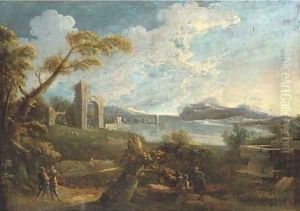Antonio Carlo Tavella, Il Solfarola Paintings
Antonio Carlo Tavella, also known as Il Solfarola, was an Italian painter of the Baroque period, born in 1668 in Milan, Lombardy. He is primarily known for his landscape paintings and architectural capriccios, which are imaginative compositions of buildings and ruins set within a landscape.
Tavella began his artistic training in his native Milan but later moved to Genoa, where he became significantly influenced by the work of local painters, particularly those of the Genoese School. In Genoa, he developed his style, which was characterized by a blend of realism and idealization, with an emphasis on light and atmospheric effects. His work often depicted the serene countryside of Northern Italy, imbued with a poetic and sometimes melancholic atmosphere.
Throughout his career, Tavella received commissions from many notable patrons, including members of the Genoese aristocracy. His landscapes and capriccios were sought after for their decorative qualities and their ability to evoke a sense of idyllic tranquility. Tavella's paintings often included classical ruins, a popular motif in the Baroque period, which served as a reminder of the passage of time and the impermanence of human achievements.
Tavella's nickname, Il Solfarola, is thought to be derived from the Italian word for sulfur, 'zolfo,' possibly indicating a particular technique or characteristic of his painting, though the exact reason for this moniker remains somewhat obscure. Despite this, the nickname has become an integral part of his identity in the history of art.
Antonio Carlo Tavella's contribution to the landscape genre was significant in that he helped to maintain the tradition of landscape painting in Italy during a period when the Baroque style was predominantly focused on historical and religious subjects. He died in 1738 in Genoa, leaving behind a body of work that continues to be appreciated for its serene beauty and atmospheric qualities. His paintings can be found in various museums and private collections, serving as a testament to his skill and artistic legacy.
